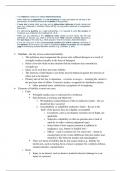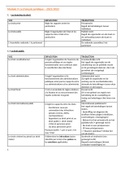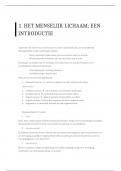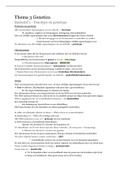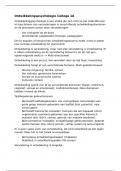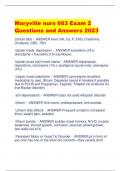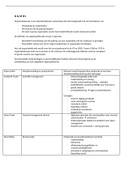o The tortfeasor must compensate the person who suffered damages as a result of
wrongful conduct (usually in the form of damages)
o Rules of tort law build on the intuition that the tortfeasor has committed a
wrongful act
o Injury on its own does not create liability
o The interests of individuals to act freely must be balanced against the interests of
others not to be harmed
o Primary aim of tort law is reparation – restitutio in integro – restoring the victim to
the previous state of affairs. Corrective justice, as opposed to distributive justice.
Other potential aims: satisfaction; recognition of wrongdoing
Elements of liability in most tort cases
o Fault
Wrongful conduct (act or omission) by a tortfeasor
Sub-elements in German and Dutch law:
1. Wrongfulness (unlawfulness) of the act (objective fault) – the act
should not have occurred
2. Accountability or culpability (subjective fault) – the act is the
‘fault’ of the person; they are culpable, accountable
o Exceptions, such as involuntary reactions out of fright, are
applicable
o Subjective culpability is often in question due to lack of
capacity to make a mature judgement (age)
o Some kinds of torts require intention in addition to
negligence. (e.g. battery in English law)
o Malice – used in common law for some torts – aimed at
causing harm to the victim (difference between malice and
intention is like between murder and manslaughter)
There are forms of liability that do not require fault (e.g., liability for
lawful acts, such as tearing down a house to prepare for a military defence,
eminent domain, expropriation)
o Harm
Injury to an interest, such as harm to material interests (damage to a car,
injury to a person)
, Defined in reference to interests
German BGB states which interests are protected for certain grounds of
liability
o Causal connection between fault and harm
Harm is caused by the fault; the injury is a result of the wrongful conduct
Causality involves two different, cumulative conditions:
1. Factual causation, for establishing a causal connection
o Condition sine qua non (c.s.q.n.) or ‘but for’ test in English
law
2. Legal causation, for limiting the extent of liability
o Compensation is not awarded for losses that are too far
removed from the act
o Precise criterion varies: remoteness (England); direct and
immediate consequence (France); adequacy (Germany);
proximate cause (USA)
o Remedies
Award of damages (sum of money paid by the defendant to the claimant)
Court order (such as an injunction) – requires the defendant to perform an
action or to refrain from certain conduct
Declaration of rights – the court declares that someone is liable without
awarding damages or other remedies (may serve as a basis for further
negotiations or provide moral satisfaction)
Others are usually variations of the above. I.e., an injunction could be the
requirement to rectify a public statement
Systems of tort law in France, Germany and
England
France – fault liability
, Art 1240 Cc – “Any human act that causes damage to another obliges the person by
whose fault it occurred to repair it”
Art 1241 Cc – “Everyone is liable for the damage they have caused not only by
intentional acts, but also by negligent conduct or by imprudence”
o ‘Fault, cause and damage’ not explained
o No explicit requirement for subjective fault
Categories of fault are not expressly stated in the articles
o Explicitly written duties
Written rules proscribing certain behavior (statutes, other rules)
Protection of subjective rights (others’ rights)
o Unwritten rules
Unwritten non-contractual duties – determined by courts; similar to
English tort of negligence
Abuse of right – intentional actions intended to harm another person
o
Incompetence of the tortfeasor is not an excuse, tortfeasor is presumed accountable for
his actions. Mentally disabled adults are not exempt (art. 414-3 Cc). Art. 1240 is
applied directly to children using an objective standard as well.
Causality is not defined, but case law established a need for c.s.q.n. connection and
legal causality (damage must be immediate and direct – art 1231-4 Cc, derived from
contract law)
Multiple tortfeasors are jointly and severally liable, i.e., liable for the whole obligation
and held to contribute for their fair share (arts 1313 and 1317 Cc)
Classification of kinds of fault in France
o
Causality in French law – required by Art. 1240 Cc, but only established in case law:
o C.s.q.n.-connection is required; legal causality as well – damage must be
‘immediate and direct’ (Art. 1231-4 Cc) to be compensated. Derived from
contract law, extends to torts.
Multiple tortfeasors

